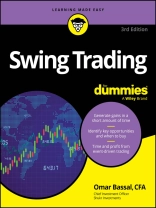Learn how to maximize profits and minimize risks trading over the short term
Swing Trading For Dummies introduces you to a trading methodology designed to generate big profits in the short term. Unlike buy and hold investing, Swing Traders endeavor to enter a stock at the precise moment a major uptrend begins and exit for a large profit a few weeks or months later. In order to achieve this result, Swing Trading For Dummies covers the tools you need to get up and running as a trader before moving on to the two main analysis techniques swing traders rely upon: technical analysis and fundamental analysis. These two analysis techniques can be combined to maximize the chances of a successful trade. But no one is perfect, and the savvy swing trader must have a comprehensive risk management plan to deal with trades that fail to launch. New in this update to Swing Trading for Dummies is material on the types of positive catalysts a trader should look for to enter a trade, the best way to trade earnings reports, swing trading cryptocurrencies and why you should avoid investing in banking stocks.
- Learn how swing trading can generate profits in a short period of time
- Identify the most attractive opportunities and when to buy them
- Avoid the common mistakes that sink many novices
- Manage risk and set yourself up for success
For new and seasoned investors looking for a comprehensive and trusted reference on swing trading, this Dummies guide is the perfect solution.
Tabela de Conteúdo
Introduction 1
Part 1: Getting into the Swing of Things 5
Chapter 1: Swing Trading from A to Z 7
Chapter 2: Understanding the Swing Trader’s Two Main Strategies 27
Chapter 3: Focusing on the Small Stuff: The Administrative Tasks 43
Part 2: Timing Is Everything: Technical Analysis 59
Chapter 4: Charting the Market 61
Chapter 5: Asking Technical Indicators for Directions 89
Chapter 6: Trend Following or Trading Ranges 117
Part 3: Incorporating Fundamental Analysis into Your Swing Trading Plan 139
Chapter 7: The Macro (Economy) and Micro (Business) 141
Chapter 8: So, What’s This Company Worth? 163
Chapter 9: Assessing a Company’s Stock: Six Tried-and-True Steps 187
Chapter 10: Sourcing: How to Find Swing Trading Candidates 205
Part 4: Planning the Trade and Trading the Plan 221
Chapter 11: Fail Fast: Managing Risk 223
Chapter 12: Knowing Your Entry and Exit Strategies 249
Chapter 13: Walking through a Trade, Swing-Style 263
Chapter 14: Looking at the Scoreboard to Evaluate Your Performance 281
Part 5: The Part of Tens 297
Chapter 15: Ten Simple Rules for Swing Trading 299
Chapter 16: Ten Deadly Mistakes of Swing Trading 309
Appendix: Helpful Resources for
Today’s Swing Trader 317
Index 327
Sobre o autor
Omar Bassal, CFA, is a Chief Investment Officer with thirty years’ experience trading stocks. He is a Chartered Financial Analyst and holds an MBA with honors from the Wharton School of Business.












